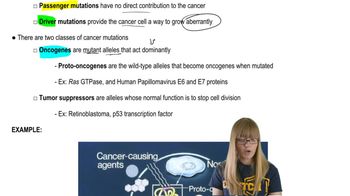Table of contents
- 1. Introduction to Genetics51m
- 2. Mendel's Laws of Inheritance3h 37m
- 3. Extensions to Mendelian Inheritance2h 41m
- 4. Genetic Mapping and Linkage2h 28m
- 5. Genetics of Bacteria and Viruses1h 21m
- 6. Chromosomal Variation1h 48m
- 7. DNA and Chromosome Structure56m
- 8. DNA Replication1h 10m
- 9. Mitosis and Meiosis1h 34m
- 10. Transcription1h 0m
- 11. Translation58m
- 12. Gene Regulation in Prokaryotes1h 19m
- 13. Gene Regulation in Eukaryotes44m
- 14. Genetic Control of Development44m
- 15. Genomes and Genomics1h 50m
- 16. Transposable Elements47m
- 17. Mutation, Repair, and Recombination1h 6m
- 18. Molecular Genetic Tools19m
- 19. Cancer Genetics29m
- 20. Quantitative Genetics1h 26m
- 21. Population Genetics50m
- 22. Evolutionary Genetics29m
19. Cancer Genetics
Cancer Mutations
Problem 6b
Textbook Question
Radiation is frequently used as part of the treatment of cancer. The radiation works by damaging DNA and components of the cell. How can radiation treatment control or cure cancer?
 Verified step by step guidance
Verified step by step guidance1
Radiation therapy targets cancer cells by using high-energy particles or waves, such as X-rays, gamma rays, electron beams, or protons.
The primary mechanism of action is the induction of DNA damage in cancer cells. Radiation causes breaks in the DNA strands, which can lead to cell death if the damage is not repaired.
Cancer cells are generally more susceptible to DNA damage than normal cells because they divide more rapidly and often have defective DNA repair mechanisms.
By damaging the DNA of cancer cells, radiation therapy can prevent them from continuing to grow and divide, leading to their eventual death.
The goal of radiation therapy is to maximize damage to cancer cells while minimizing exposure and damage to surrounding healthy tissue, often achieved through precise targeting and dosing.
Recommended similar problem, with video answer:
 Verified Solution
Verified SolutionThis video solution was recommended by our tutors as helpful for the problem above
Video duration:
6mPlay a video:
Was this helpful?
Key Concepts
Here are the essential concepts you must grasp in order to answer the question correctly.
DNA Damage and Repair
Radiation therapy primarily works by inducing damage to the DNA within cancer cells. This damage can lead to mutations or cell death if the cells are unable to repair the DNA effectively. Normal cells have robust repair mechanisms, but cancer cells often lack these, making them more susceptible to radiation-induced damage.
Recommended video:
Guided course

Repair Pathways
Cell Cycle and Apoptosis
Cancer cells typically divide more rapidly than normal cells, making them more vulnerable during specific phases of the cell cycle. Radiation can trigger apoptosis, or programmed cell death, in these damaged cells. Understanding the cell cycle helps in timing radiation treatment to maximize its effectiveness against cancer cells.
Recommended video:
Guided course

Bacteriophage Life Cycle
Targeting Tumor Microenvironment
Radiation therapy not only affects cancer cells but also impacts the tumor microenvironment, which includes surrounding cells, blood vessels, and immune cells. By damaging the supportive structures of the tumor, radiation can inhibit its growth and enhance the effectiveness of other treatments, such as immunotherapy.
Recommended video:
Guided course

Cancer Characteristics

 4:50m
4:50mWatch next
Master Cancer Mutations with a bite sized video explanation from Kylia Goodner
Start learningRelated Videos
Related Practice


